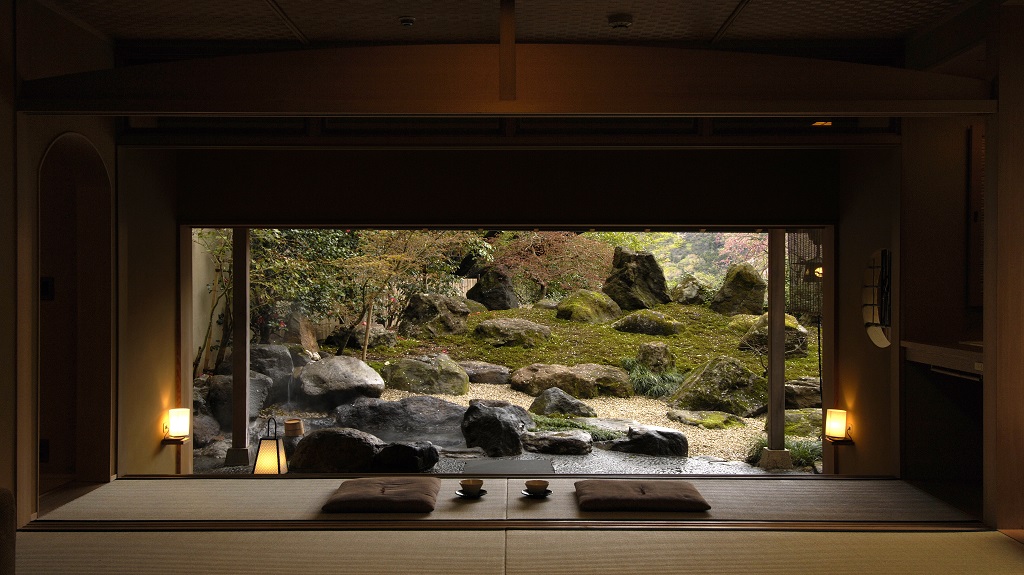
We consider a ryokan stay (a traditional Japanese inn) to be the quintessential cultural immersion experience and essential activity on any Japan private tour! Originally dating back to the 8th century, even the more notable luxury ryokans may seem quite simple and spartan, compared to 5-star hotels. In contrast to the western notion of opulent amenities, spas, and sleek electronics, a ryokan’s understated sense of luxury is reflected in its high-touch spirit of personal service and hospitality known as “Omotenashi”. With sincerity and pursuit of aesthetic perfection, ”Kodawari”, your ryokan’s kimono-clad personal attendant is trained to anticipate your needs, displaying an appearance and conduct mirroring the finest qualities of Japanese culture.
The most notable ryokans we have experienced and listed below, (including Tawaraya and Hiiragiya) showcase traditional Japanese aesthetics with the works of craftsmen, artisans, and artists displayed on the walls of the rooms and public areas. Even the flowers are meticulously arranged to symbolize the various seasons. Each room features tatami floors, ”shoji” paper windows, “fusuma” doors, comfortable sleeping futons, a traditional cypress wood tub, and a table with supplies for making tea and for your “kaiseki” dinner presentation.
The multi-course kaiseki dinner is the highlight of your ryokan stay. Conceived during the Samurai period 400 years ago, this unique dining experience was created to serve only the Emperor and his guests. The beautifully presented, multi-course meal is served with seasonal bites arriving in lacquerware bowls and boxes. Rest assured you will experience a full range of cooking styles, including grilled mackerel, fried scallop, streamed turnip with cod, and seasonal varieties of local vegetables. A wide selection of sake and wine also available. Though we really enjoy the traditional Japanese breakfast, ryokans also offer a tasty western breakfast option. Enjoy!
As an added cultural experience while enjoying your kaiseki dinner in your room, we may also arrange special, private geisha entertainment. A Geiko (geisha term in Kyoto), Maiko (apprentice Geiko) and Jikata (musician Geiko) charm you with traditional Japanese song and dance. Our Lynch and Xu families having experienced this at Hiiragiya ryokan, rest assured this is a unique, once-in-a-lifetime experience!
Please enjoy this list of our top favorite ryokans and be sure to check out Randy Lynch’s tips for staying at a ryokan at the end:
Hakone

Gora Kadan
Gora Kadan is a contemporary take on a traditional Japanese ryokan (traditional inn) that has managed to compromise gracefully with the modern Western world. Proprietress Mikawako, the third generation of Fujimotos to run Gora Kadan, has blended traditional Japanese ryokan hospitality with modern Western design in creating a luxurious ryokan spa experience. The Gora Kadan’s original building dates back 300 years and was the summer home of the Kan’in-No-Miya imperial family. With its airy east-west fusion aesthetic, wonderful (Kaiseki) food service, and total relaxation spa, Gora Kadan is definitely on our A-list for high-touch ryokans in Japan!

We love the new Bettei Suite at Gora Kadan! (2021)
Gora Byakudan
Located in the same natural hot-springs-rich area of Hakone as our beloved Gora Kadan, the 16-room luxury Gora Byakudan represents a smaller, more traditional Japanese style ryokan versus the more east-west fusion aesthetic of the 39-room Gora Kadan. Similar to another favorite Hakone ryokan, Hakone Ginyu, Gora Byakudan features private open-air natural hot springs in EACH of its 16 rooms, a relaxing wonderful plus for staying here! We also like the peaceful, serene setting here with beautiful views of the surrounding forest tree groves and the far Hakone Mountain range and Daimonji-Yaki. Byakudan also includes a wonderful Spa Koudan featuring Esalen massage. Bev and I are big fans of Esalen massage, having experienced during our stays at the Esalen Institute in Big Sur, CA(!) Other amenities, pleasures we enjoy here is the Matcha Tea lounge, the ryokan’s expansive lobby views of the surrounding area, the choice of traditional Japanese style or mixed Western/Japanese style, and lastly, the deliciously prepared “kaiseki’ dinners. Enjoy the ryokan’s spirit and rich earthy smell of sandalwood.

Ginyu Ryokan
Though the east-west fusion luxury Gora Kadan Ryokan was our Lynch family’s first introduction to onsen in Hakone, we are also big fans of Ginyu Ryokan in Hakone. Despite having only 20 rooms, what stands out about Ginyu is that every single room has a private onsen and a terrace with views over the dense forest below. When first checking in one is most impressed with the aesthetically pleasing deck terrace overlooking the Hayakawa River. Ginyu’s four lodging types include “Hoshi” rooms, featuring a private onsen (open-air hot spring bath!), sliding wooden doors with lovely paper windows, a separate dining area (delicious Kaiseki dinners!), and traditional Japanese futon mattresses. Limited Western-style beds are available, though must be requested well in advance. Though small, the spa offers various relaxing massage/treatment experiences. Enjoy!
Kyoto

Hiiragiya
Similar to Tawaraya Ryokan (just across the alley-way), Hiiragiya is considered among the most noteworthy and famous ryokans in all of Japan. Improbably, two of the most famous luxury ryokans in all of Japan stand directly across from each other! A stay at Hiiragiya or Tawaraya represents a complete immersion into traditional Japanese culture. Enclosed in a traditional sukiya style wooden structure, Hiiragiya was conceived in 1818 when Hiiragiya, a seafood dealer, began providing accommodation to traveling merchants. Later, Hiiragiya welcomed many members of the imperial family including writers, governing officials, and international celebrities. Proprietress Akami Nishimura’s family has run the ryokan for six generations, since its inception. She only modestly acknowledges the many world leaders and celebrities that have stayed here, including the imperial family and Charlie Chaplin! The always in demand corner room #14 is our Lynch family favorite! Ms. Nishimura may also arrange a truly special private a geiko/maiko (geisha) entertainment experience while in your room. We give an A+ to both the Tawaraya and Hiiragiya, although we feel Hiiragiya is perhaps more accommodating and open to Western eccentricities.

Tawaraya
Similar to Hiiragiya, Tawaraya is one of the two most historic and written about ryokans in all of Japan, especially if judged by the noteworthy guests that have been served here. Amazingly, two of the most famous ryokans in Kyoto are located directly across the alleyway from each other. It’s difficult for us to choose between Tawaraya from Hiirigiya –they both represent the very highest level of service. The Tawaraya experience has been described as Japanese culture in miniature, a metaphor for inner calm in the face of outer turmoil. A recent Kipling & Clark client summed up his stay here as “the essence of perfection.”

Miyamasou
Known for its impeccable food and tsumikusa cooking style (freshly picked and foraged ingredients), Kyoto’s Miyamasou was founded by Chef Nakahigashi’s great-grandfather over 100 years ago. What began as a hostel for pilgrims making the voyage up the 400 steps to the Daihizan Bujoji temple, has become a sought-after lodging and dining experience. In recent years, Nakahigashi’s son, Hisato, has applied his own spin to the tsumikusa tradition. In classic ryokan style, the sleeping room is serene and simple with the sound of flowing water drifting through the window. While there isn’t an onsen, for a relaxing experience, mountain spring water is warmed and poured into a wooden bath.
Kanazawa

Kayotei
The Lynch family first discovered this heavenly place back in 2014. An approximately 1.5-hour drive south of Kanazawa, this 10-room ryokan retreat is arranged in traditional sukiya style, overlooking the pristine nearby Yamanaka River. The Kayotei’s onsen/hot springs overlooking the deep-forested hills, provide a quiet, relaxing sanctuary for those wishing for a remote getaway. A walk along the river trails offers an invigorating experience before being served the Kayotei’s locally-sourced kaiseki dinner. Being such a noteworthy local ryokan, the Kayotei highlights the work of local artisans: woodworkers, papermakers, soy sauce brewers, among others!
Shikoku

Iya Valley Onsen
We enthusiastically recommend the obscure, somewhat spartan 23-room, more modern take on the classic ryokan, Iya Valley Onsen Hotel. The Iya Valley Onsen is located in the pristine Iya Valley, among the most remote forest areas of Shikoku. In addition to enjoying fresh Kaiseki fish dinners (from the nearby Iya river!), and personal, high-touch service, the two unique experiences here are the onsen/hot water springs, and the quiet, lush, green forest trails. The Iya Valley Hotel offers a cable-car down to the open-air baths at the bottom of the valley, an unparalleled and relaxing experience!

Tips for Staying at a Ryokan:
- The proprietress and maids will welcome you at the entrance. In most cases, the entire staff will welcome you when you arrive. If you come earlier than expected and find nobody at the entrance, just call out “Gomenkudasai!” (Hello!) and some of the staff will hurry out to greet you.
- Please take off your shoes and change into slippers. At most inns, guests are expected to take off their shoes at the entrance. If there is a footstool, you can place one foot on it while removing your other shoe before you enter the hallway. Put on a pair of slippers if provided, but make sure to take them off before entering a tatami-floored room. Historically, when tatami mats first came into use during the Heian period (794-1185), they were spread out only when people were going to bed or were to be seated. For this reason, people began to remove any kind of footwear before stepping on the tatami.
- In the lobby, exchange greetings with the proprietress and sip some tea. Upon arrival, you will be shown into the lobby and offered a beverage, such as green tea, to relax and soothe your spirit. After taking a short rest, you will receive a few words of greeting from the proprietress. Most inns have few, if any, English-speaking staff.
- Have a bowl of matcha (powdered green tea). The tea bowl should be held with both hands. Matcha is stronger than normal green tea and is served in a bigger bowl.
- Do not put your luggage in the alcove. The ornamental recess raised one step above the tatami floor, is an auspicious place adorned by a hanging scroll, a vase, or flower arrangement. It is taboo to place luggage, handbags, or other articles there.
- Follow a maid(s) to your guestroom. Guests are led to their rooms from the lobby by the maid(s) in charge of their care. She will be responsible for assisting you to make your stay comfortable. Direct any questions or requests concerning the inn to her. Upon entering your room, you will be informed of the time for dinner and receive suggestions for bath time.
- For gratuity, there is a custom of putting some money into an envelope and giving it to the maid as an expression of gratitude. It is not obligatory, however. If you wish to express appreciation, the money must be placed into a small envelope or wrapped in tissue paper before you present it.

